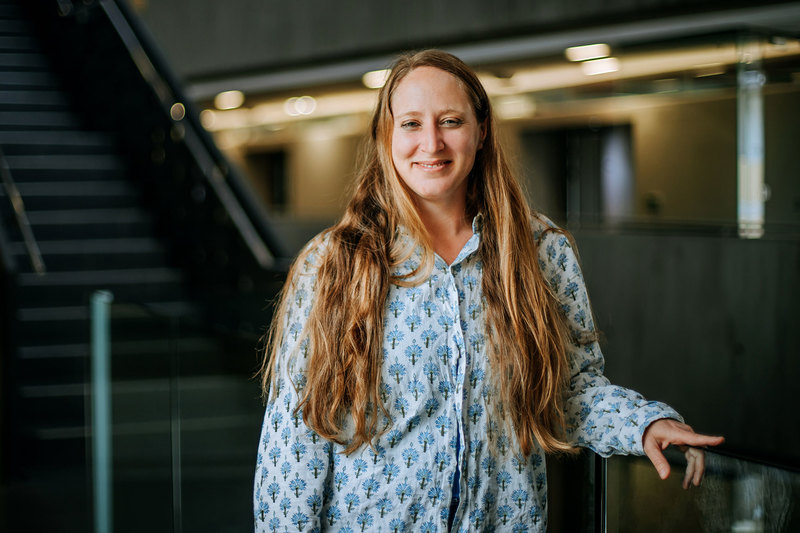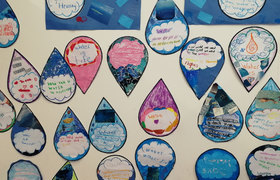UCT researcher to contest Berlin Falling Walls Engage
26 October 2022 | Story Helen Swingler. Photo Candice Lowin. Read time 6 min.
A second University of Cape Town (UCT) innovator, Dr Amber Abrams of the Future Water Institute, will be pitching at the Berlin Science Summit in Germany in November. Dr Abrams will participate in the Falling Walls Engage 2022 competition, having been named a regional winner in the Falling Walls Engage competition for her work in public science communication around water resources.
Falling Walls is a global platform for young innovators and scientists to introduce their “breaking walls” ideas to the world. The link is to the Berlin Wall, which fell in 1989 after separating East and West Berlin for nearly 28 years.
Abrams will join 19 other global winners in the Engage category, vying for the “champion of champions” title. She will be in good company. UCT’s Emma Horn, a PhD candidate in the Department of Civil Engineering, will be competing for laurels in the Falling Walls Lab competition, a category for young innovators. Horn won Falling Walls Lab Cape Town with her ‘green’ bio-tile innovation, which is set to shake up the fossil-fuel-reliant ceramic tile and construction industries.
Links and collaborations
Abrams is a Carnegie Developing Emerging Academic Leadership (DEAL) research fellow at the institute. Her work focuses on social sciences and human health around water, through the Museum of Watery Relations and the interactive Water Map and other community outreach partnerships.
Water is a precious resource, under threat from climate change, pollution and other environmental and structural mismanagement. Protecting water sources and health is a shared responsibility among many role players, as Day Zero in Cape Town showed.
The online and interactive Water Map is a collaborative arts-based project for all South African citizens, although its focus is on residents of Cape Town. It draws on transdisciplinary water values-related research to map and co-produce knowledge around various relations with water systems.
The platform is accessible to anyone interested in building the body of water knowledge. Individuals can input their water sources, related stories, images, art, or other efforts. Groups and organisations linked to water can share their projects and network with others.
“It gives them a dedicated space to think about and express how they connect to water.”
The public become key stakeholders in the process. Using the pooled information, water researchers can build a bigger understanding of local water users and their perceptions and relationships with water: how they use it, where they source it, and how they protect it.
“This helps researchers and funders understand the water-use and water-engagements landscape,” Abrams noted. “It gives them a dedicated space to think about and express how they connect to water: where their water goes and what they put into that environment. These spaces are all interconnected.
The Museum of Watery Relations and the Water Map also serve as an international network for people engaged in projects that transform human relationships with water.
Among the global network of similar facilities, the Museum of Watery Relations is one of only two in Africa. Last year, Burkina Faso created Le Musée de l’Eau as a space for valuing water as a resource at cultural, sociological, anthropological, and political levels. The museum is a partnership with Keepers of the Waters, a non-profit organisation and a project of the Institute for Releasing Initiative.
“It’s important to have an African space to do that. The continent must be represented in some way.”
“It’s important to have an African space to do that. The continent must be represented in some way,” said Abrams.
A multi-faceted researcher, Abrams’ undergraduate degree at Columbia University in the United States was followed by a master’s degree at UCT and a PhD at the University of Kent in the United Kingdom. Her doctoral research drew on her interests in public health, medical and environmental anthropology and studies in conservation and ecology.
Her study was based in South Africa. Working in northern Limpopo, she studied the well-being of a community living at the edge of a nature reserve. Her focus was on medicinal plant use of the boundary of a nature reserve.
But because of the drought there, her focus turned to water.
She later joined UCT’s Future Water Institute as a postdoctoral research fellow and is now a junior research fellow with the institute.
Although the prospect of selling her work live on stage at Berlin Falling Walls Engage is “terrifying”, it’s a valuable opportunity to learn about other projects and see how others think about science engagement.
“It’s an opportunity to explain what we’re trying to do at the Museum of Watery Relations and with the Water Map. It will be useful to get feedback about how others might have done things differently – or similarly.”
Community engagement, especially with young people and young citizen scientists, is crucial, Abrams said. Her work with the Future Water Institute is a reminder of the future.
“For me, engagement with young people is a space to see real change into the future. I like the idea of working with people who are going to be the holders of our water futures.”
 This work is licensed under a Creative Commons Attribution-NoDerivatives 4.0 International License.
This work is licensed under a Creative Commons Attribution-NoDerivatives 4.0 International License.
Please view the republishing articles page for more information.










